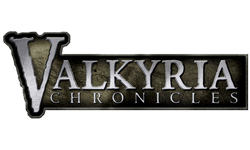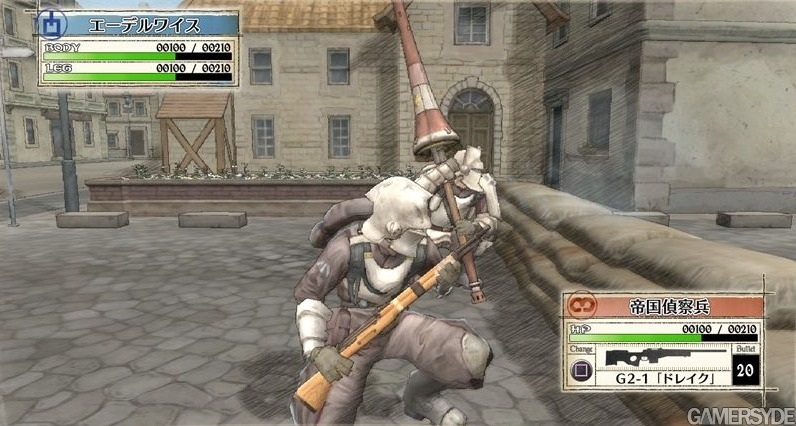|
|

|
PLATFORM
|
PS3
|
BATTLE SYSTEM
|

|
INTERACTION
|

|
ORIGINALITY
|

|
STORY
|

|
MUSIC & SOUND
|

|
VISUALS
|

|
CHALLENGE
|
Moderate
|
COMPLETION TIME
|
40-60 Hours
|
|
OVERALL

|
+ Excellent presentation
+ Fresh take on strategy RPGs
+ Compelling storyline
- AI could be better
- Lack of interaction in spots
|
Click here for scoring definitions
|
|
|
Every once in awhile a game comes along that challenges what you know about gaming. This can be on any front – storyline, gameplay, presentation, or any combination of the three – and it leaves such a lasting impression that you can easily see yourself playing it again a decade down the road, long after homogenized imitators on newer, faster, and shinier consoles take over the spotlight. With its fresh approach to the strategy RPG paradigm and compelling narrative, Valkyria Chronicles is one such game that we will hopefully look back on with such esteem. It’s different in ways that make sense. It’s a powerful blend of emotional storytelling, high-stakes combat, and next-gen presentation. It’s a work of art.
The narrative is set in an alternative 1930s Europe (called Europa), with tensions between the Atlantic Federation and the Eastern European Imperial Alliance threatening to spark another conflict in a series of devastating wars. Caught in the middle of the struggle is Gallia, a small and independent country with an abundance of a do-it-all resource known as ragnite which is coveted by both powers. The game begins in the border town of Bruhl just as the Empire launches its invasion of Gallia. After fending off a group of Imperials, Welkin, his adopted sister Isara, and newfound friend Alicia head for Gallia’s capital of Randgriz to join the militia. They are assigned to Squad 7, a ragtag bunch of citizens from all walks of life who saw their hometowns or lives ruined by the Empire and are looking to defend their homeland (or in some cases, exact revenge) in whatever way they can. Although relationships between the members are rocky and distrustful at first, as the game progresses Squad 7 begins to gel both as part of the Gallian militia and as a family, and a core set of characters are developed to a satisfying conclusion. The player should expect to identify with at least one of the main characters, as many different emotional and ethical issues are tackled in a mature manner throughout the course of the game. The narrative is executed similar to an anime series – the first few chapters are spent introducing the characters and the back story, then from there the primary arc is delivered in the midst of “problem a week” episodes resulting in Welkin calling on Squad 7 to move out and complete the assigned operation.
The narrative’s episodic nature is delivered through a book called On the Gallian Front. Each chapter is illustrated with a series of pictures and maps, which the player selects to either trigger a story event or start a mission. The book is intended to serve as the game’s interface while not in combat and performs its functions adequately, but makes the game extremely linear with very little to do in between operations. During story events the player simply sits and advances the dialogue. Personally, I might have liked to see points in the story where I’m given a decision of some sort to make that would for example change the operation parameters. On the Gallian Front also includes a series of tabs which the player accesses for game-related tasks that are peripheral to the progression of the game. This includes technical information on all the weapons the characters have access to, dossiers of all the characters in the game, an extraordinarily-detailed glossary explaining who the Federation and the Empire are as well as Europa’s history, and a display of all the decorations Squad 7 receives for its service to Gallia. While some of this is optional, those who are interested in the characters or Europa’s history will enjoy the reading.
 Stay here, I need to go take a leak
Stay here, I need to go take a leak
|
|
One of the more interesting mechanics of the game is the way in which rewards are distributed after operations are completed. Unlike in most other games where experience is awarded individually for a character’s participation in combat, Squad 7 is awarded a lump sum of experience and DCT points which the player spends in whatever manner they see fit. The experience points are used for leveling classes, as opposed to leveling individual characters. DCT points serve in the role of currency for the game, to two ends. First, they are used at the R&D Department of Headquarters to upgrade Squad 7’s weapons, armor, and tanks. Second, they are also used to purchase Reports from Squad 7’s embedded journalist, Ellet. Completion of a character’s respective Report unlocks a unique Potential.
So how do you really differentiate between characters if they’re all the same levels and they all get the same gear from R&D? That is another point where Valkyria Chronicles separates itself from the pack. Each character has a unique set of Potentials which randomly trigger a positive or negative status effect in combat based on certain situations, for example being around a certain character or standing on a city street or a grassy field. Each character also has a list of characters they work well with. For example moving Alicia close to Dallas and attacking a target will cause Dallas to start attacking the same target as well. This is a nice aspect to keep in mind when determining who to put into combat. As a bonus, upgraded gear which is superior to what comes from R&D is available in limited quantities. This allows the player to fit a few characters with even better weapons.
Typically what separates strategy RPGs from their traditional brethren is the combat system. That is, a character is selected and moved a certain number of spaces on the grid, and the option of taking some sort of action is allowed throughout. Valkyria Chronicles challenges this by taking the grid off the map and adding a third-person action mode, using a system termed by Sega as BLITZ (Battle of LIve Tactical Zones). At the start of each phase, the player is allotted a certain number of Command Points to use however they see fit, including using a unit multiple times in the same phase. Unit movement and actions are handled through a third-person interface in which buildings become shelters from enemy fire and sneaking up behind enemy units gives you a decided advantage. The camera is freely rotatable around the active unit and rarely (if ever) gets in the way of the player playing the game. BLITZ is a thoroughly enjoyable take on the strategy element of the game.
 The girl or the tank?
The girl or the tank?
|
|
Part of what makes BLITZ (and indeed, the game’s visual presentation as a whole) successful is Sega’s other fancy marketing buzzword for this game, the CANVAS engine. From the moment you turn on the game you see an outline of a tank being drawn, colored, and being brought to life with Welkin and Alicia riding atop. The game’s unique artistic feel is presented in such a way that it’s literally like watching an interactive water-colored animation. It is vibrant, the colors are well-defined, and the framerate is steady throughout, save for the odd spot in combat where there is heavy traffic.
Accompanying the game’s impressive visuals is a fully-voiced script and a stellar soundtrack. I chose to listen to the Japanese dialogue through most of the game and found it loaded with appropriately-cast voices - Welkin is the boyish protagonist, Largo is the gruff veteran, Emperor Maximilian is a pompous bastard, and so on. In spots where I listened to the English dialogue, I found it to be more than passable. Chatter coming in over the radio during combat isn’t subtitled for the benefit of those who don’t speak Japanese, but it is useless stuff like “Leave it to me!” or “Enemy spotted!” The soundtrack is composed by Hitoshi Sakimoto, who should require no introduction for soundtrack aficionados. His signature orchestral flair is in fine form, with soaring wind and brass leads taking point ahead of string backings. The battle themes convey a sense of dramatic urgency and the theme at the graveyard is absolutely beautiful.
As with other strategy RPGs, the difficulty of the game is linked to how well the player understands the AI. Unfortunately for Valkyria Chronicles, the AI is incredibly stupid. Scouts across the map routinely circle all the way around buildings with no clear objective, tanks leave their weak points exposed, and in rare incidents I’ve seen enemy units take each other out with friendly fire. Getting through an operation successfully is a matter of understanding how the operation is supposed to play out, not recklessly leaving characters exposed to focused fire, and not presenting an enemy with a clear look at the radiator on the back of Welkin’s tank. Still, the operations do take time to finish and completing the game can take a good 35-50 hours, depending on how much time is spent stopping to smell the flowers along the way. A new game plus mode is available for the completionist who wants to go back and get all the unlockable goodies after finishing the game.
To measure Valkyria Chronicles as the sum of its individual parts is to sell it short. Any game can boast a sparkly 3D engine or any of the other features mentioned above, but putting all of the elements that this game has to offer into one package turns it into an experience that has to be played to believe. While not without its faults, Valkyria Chronicles takes a powerful narrative with all the political intrigue that’s expected of strategy games and melds it with the pacing and character development of an extremely well-done anime series. Addictingly fun gameplay is matched with top-notch visuals and audio, keeping all but the most restless of players glued to their seats for hours on end. This game is a strong argument to take into consideration for those who can’t decide between the Xbox 360 and the Playstation 3, and those who do own a Playstation 3 should not think twice about at least checking the demo out, if not just running to the store and getting a copy. I for one can only hope that future strategy RPGs are anywhere near this good.
Review Archives
|









